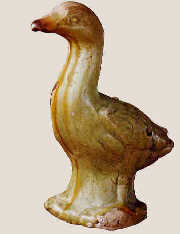 Tri-colored Duck Potteries of the Tang Dynasty
Tri-colored Duck Potteries of the Tang Dynasty

The history of raising duck in China can be dated back to the Neolithic Age four or five thousand years ago. Primitive Chinese at this stage began to settle and tame wild animals for husbandry. Gradually, wild ducks were transformed into domesticated ducks.
China's earliest duck potteries ever found were unearthed from the remains ofYangshaoCulture 4,000 years ago, located in Shanxian County, centralHenan Province. In 1954, a painted gray duck pottery was excavated from the remains of Eligang Culture 2,000 years ago, located inZhengzhou, Henan. Now collected in theNational Museumof China, the ceramic duck stands in a plate, about to fly. It is obviously a domesticated duck.
China became one of the world's most powerful empires in the Tang Dynasty . Animal husbandry developed rapidly at that time, thanks to luxurious life of noblemen and landlords. Among unearthed tri-colored Tang potteries from noblemen's tombs near the capitals of the Tang Dynasty, livestock accounts for the largest part. A green gilded duck pottery was excavated from a Tang tomb in Shaanxi in the 1950s. Gilded with green and dotted with yellow and brown, the pottery features a Hedging duck. It looks ripen and awkward, with innocent and funny facial-expression.
Tri-colored Tang potteries were mostly unearthed from tombs of landlords or noblemen of the Tang Dyansty. Tombs of ordinary people usually only have common potteries. According to archeological discoveries, kilns producing tri-colored Tang potteries are mainly located in Gongxian County of Henan, Tongchuan of Shaanxi, suburb of Xi'an and Renqiu County of Hebei.
For animal-shape tri-colored Tang potteries, they were first cast in molds and then carved in detail. Those animal-shape potteries usually feature realistic styles, with much emphasis on lines and grandeur.
